A New Method for Distribution Network Reconfiguration Analysis under Different Load Demands
Abstract
:1. Introduction
2. Problem Formulation
2.1. Power Flow
2.2. Objective Function
2.3. Constraints
- Bus voltage ought to be inside the upper and lower limits as shown in Equation (8).where Vi,min and Vi,max are the minimum and maximum voltage boundaries of bus i; Nb represents the total number of branches.
- Branch current magnitudes should not exceed the designed overcurrent limitation of each branch as shown in Equation (9).where Ij,max is the current upper limit of branch j; Nn represents the total number of buses in distribution network.
- Always keep the network structure as radial as shown in Equation (10).where A is the incidence bus matrix.
2.4. Average Voltage Concept
3. Reconfiguration Method
- -
- Velocity upgrading of each particle per Equation (13)i = 1, 2, …, ND, j = 1, 2,…, Npar
- -
- Position updating according to Equation (14)
- -
- Inertia weight updating according to Equation (15)
| Algo1 |
| Step 1: Start. |
| Step 2: Set initial (generation of the swarm, velocity, Pbest matrix, random Gbest, wmax and wmin). |
| Step 3: Read system data and perform load flow. |
| Step 4: Set maximum iterations = iter. |
| Step 5: Calculate fitness function for Pbest. |
| Step 6: Iter = iter − 1. |
| Step 7: Update (velocity using Equation (13), position using Equation (14) and weight coefficient using Equation (15)). |
| Step 8: Calculate fitness function for each particle. |
| Step 9: If not satisfying all constraints in Equations (8)–(10) then go to Step 6; otherwise go to Step 10. |
| Step 10: If particle fitness > Pbest fitness then go to Step 6; otherwise go to Step 11. |
| Step 11: Pbest fitness = particle fitness. |
| Step 12: If iter = 0 then go to Step 13; otherwise go to Step 6. |
| Step 13: Print the results (switches sets, TPL, TQL, TSL, Vav, Vmin). |
| Step14: Stop. |
3.1. MPSO Parameters
3.2. Load Demand Variation
3.2.1. Case 1
| Algo2 |
| Step 1: Start. |
| Step 2: Read line and load data of the test network. |
| Step 3: Compute the new PLi and QLi using Equations (18) and (19). |
| Step 4: Read the tie-lines configuration set. |
| Step 5: Perform load flow on new load demand (active and reactive). |
| Step 6: Print the results (switches sets, TPL, TQL, TSL, Vav, Vmin). |
| Step 7: Repeat steps 4–6 and find the results based on the different configurations. |
| Step 8: Find the optimal switches set based on the objective function. |
| Step 9: Repeat steps 2–8 and find the results based on the different ratio µ. |
| Step 10: Stop. |
3.2.2. Case 2
| Algo3 |
| Step 1: Start. |
| Step 2: Read line data and system data (including PLi0 and QLi0), α and β. |
| Step 3: Set Vi0 = 1. |
| Step 4: Read the tie-lines configuration set. |
| Step 5: Perform load flow and calculate Vi. |
| Step 6: Compute active and reactive power demand (PLi0 and QLi0). |
| Step 7: Compute the new PLi and QLi using Equations (26) and (27). |
| Step 8: Perform load flow based on new PLi and QLi. |
| Step 9: Print the results (switches sets, TPL, TQL, TSL, Vav, Vmin). |
| Step 10: Repeat steps 4–9 and find the results based on the different configurations. |
| Step 11: Find the optimal switches set based on the objective function. |
| Step 12: Repeat steps 2–11 and find the results based different α and β. |
| Step 13: Stop. |
3.2.3. Case 3
4. Case Study
5. Results and Discussion
5.1. Result of Case 1
5.2. Result of Case 2
5.3. Result of Case 3
6. Conclusions
Acknowledgements
Author Contribution
Conflict of Interest
References
- Kalambe, S.; Agnihotri, G. Loss minimization techniques used in distribution network: Bibliographical survey. Renew. Sustain. Energy Rev. 2014, 29, 184–200. [Google Scholar] [CrossRef]
- Mohamed Imran, A.; Kowsalya, M. A new power system reconfiguration scheme for power loss minimization and voltage profile enhancement using fireworks algorithm. Int. J. Electr. Power Energy Syst. 2014, 62, 312–322. [Google Scholar] [CrossRef]
- Niknam, T.; Azadfarsani, E.; Jabbari, M. A new hybrid evolutionary algorithm based on new fuzzy adaptive PSO and NM algorithms for distribution feeder reconfiguration. Energy Convers. Manag. 2012, 54, 7–16. [Google Scholar] [CrossRef]
- De Oliveira, L.W.; de Oliveira, E.J.; Gomes, F.V.; Silva, I.C.; Marcato, A.L.M.; Resende, P.V.C. Artificial immune systems applied to the reconfiguration of electrical power distribution networks for energy loss minimization. Int. J. Electr. Power Energy Syst. 2014, 56, 64–74. [Google Scholar] [CrossRef]
- Tomoiagă, B.; Chindriş, M.; Sumper, A.; Sudria-Andreu, A.; Villafafila-Robles, R. Pareto optimal reconfiguration of power distribution systems using a genetic algorithm based on NSGA-II. Energies 2013, 6, 1439–1455. [Google Scholar] [CrossRef]
- Shirmohammadi, D.; Hong, H.W. Reconfiguration of electric distribution networks for resistive line losses reduction. IEEE Trans. Power Deliv. 1989, 4, 1492–1498. [Google Scholar] [CrossRef]
- Sathish Kumar, K.; Jayabarathi, T. Power system reconfiguration and loss minimization for an distribution systems using bacterial foraging optimization algorithm. Int. J. Electr. Power Energy Syst. 2012, 36, 13–17. [Google Scholar] [CrossRef]
- Naveen, S.; Sathish Kumar, K.; Rajalakshmi, K. Distribution system reconfiguration for loss minimization using modified bacterial foraging optimization algorithm. Int. J. Electr. Power Energy Syst. 2015, 69, 90–97. [Google Scholar] [CrossRef]
- Gupta, N.; Swarnkar, A.; Niazi, K.R. Distribution network reconfiguration for power quality and reliability improvement using genetic Algorithms. Int. J. Electr. Power Energy Syst. 2014, 54, 664–671. [Google Scholar] [CrossRef]
- Duan, D.-L.; Ling, X.-D.; Wu, X.-Y.; Zhong, B. Reconfiguration of distribution network for loss reduction and reliability improvement based on an enhanced genetic algorithm. Int. J. Electr. Power Energy Syst. 2015, 64, 88–95. [Google Scholar] [CrossRef]
- Saffar, A.; Hooshmand, R.; Khodabakhshian, A. A new fuzzy optimal reconfiguration of distribution systems for loss reduction and load balancing using ant colony search-based algorithm. Appl. Soft Comput. 2011, 11, 4021–4028. [Google Scholar] [CrossRef]
- Carpaneto, E.; Chicco, G. Distribution system minimum loss reconfiguration in the hyper-cube ant colony optimization framework. Electr. Power Syst. Res. 2008, 78, 2037–2045. [Google Scholar] [CrossRef]
- Nguyen, T.T.; Truong, A.V. Distribution network reconfiguration for power loss minimization and voltage profile improvement using cuckoo search algorithm. Int. J. Electr. Power Energy Syst. 2015, 68, 233–242. [Google Scholar] [CrossRef]
- Salazar, H.; Gallego, R.; Romero, R. Artificial neural networks and clustering techniques applied in the reconfiguration of distribution systems. IEEE Trans. Power Deliv. 2006, 21, 1735–1742. [Google Scholar] [CrossRef]
- Fang, H.; Chen, L.; Shen, Z. Application of an improved PSO algorithm to optimal tuning of PID gains for water turbine governor. Energy Convers. Manag. 2011, 52, 1763–1770. [Google Scholar] [CrossRef]
- Cai, J.; Ma, X.; Li, Q.; Li, L.; Peng, H. A multi-objective chaotic particle swarm optimization for environmental/economic dispatch. Energy Convers. Manag. 2009, 50, 1318–1325. [Google Scholar] [CrossRef]
- Niknam, T.; Mojarrad, H.D.; Meymand, H.Z. A novel hybrid particle swarm optimization for economic dispatch with valve-point loading effects. Energy Convers. Manag. 2011, 52, 1800–1809. [Google Scholar] [CrossRef]
- Selvakumar, A.I.; Thanushkodi, K. A new particle swarm optimization solution to Nonconvex economic dispatch problems. IEEE Trans. Power Syst. 2007, 22, 42–51. [Google Scholar] [CrossRef]
- Deepa, S.N.; Sugumaran, G. Model order formulation of a multivariable discrete system using a modified particle swarm optimization approach. Swarm Evol. Comput. 2011, 1, 204–212. [Google Scholar] [CrossRef]
- Savio, A.; Bignucolo, F.; Sgarbossa, R.; Mattavelli, P.; Cerretti, A.; Turri, R. A novel measurement-based procedure for load dynamic equivalent identification. In Proceedings of the 2015 IEEE 1st International Forum on Research and Technologies for Society and Industry Leveraging a better tomorrow (RTSI), Torino, Italy, 16–18 September 2015. [Google Scholar]
- Price, W.W.; Chiang, H.-D.; Clark, H.K.; Vaahedi, E. Load representation for dynamic performance analysis (of power systems). IEEE Trans. Power Syst. 1993, 8, 472–482. [Google Scholar]
- Milanović, I.V.; Matevosiyan, J.; Borghetti, A.; Djokić, S.Z.; Dong, Z.Y. Modelling and Aggregation of Loads in Flexible Power Networks; CIGRE Technical Brochure 566; CIGRE: Paris, Frace, 2014. [Google Scholar]
- Mousavi, S.M.; Abyaneh, H.A. Effect of load models on probabilistic characterization of Aggregated load patterns. IEEE Trans. Power Syst. 2011, 26, 811–819. [Google Scholar] [CrossRef]
- Bayat, A.; Bagheri, A.; Noroozian, R. Optimal siting and sizing of distributed generation accompanied by reconfiguration of distribution networks for maximum loss reduction by using a new UVDA-based heuristic method. Int. J. Electr. Power Energy Syst. 2016, 77, 360–371. [Google Scholar] [CrossRef]
- Dall’Anese, E.; Giannakis, G.B. Sparsity-Leveraging reconfiguration of smart distribution systems. IEEE Trans. Power Deliv. 2014, 29, 1417–1426. [Google Scholar] [CrossRef]
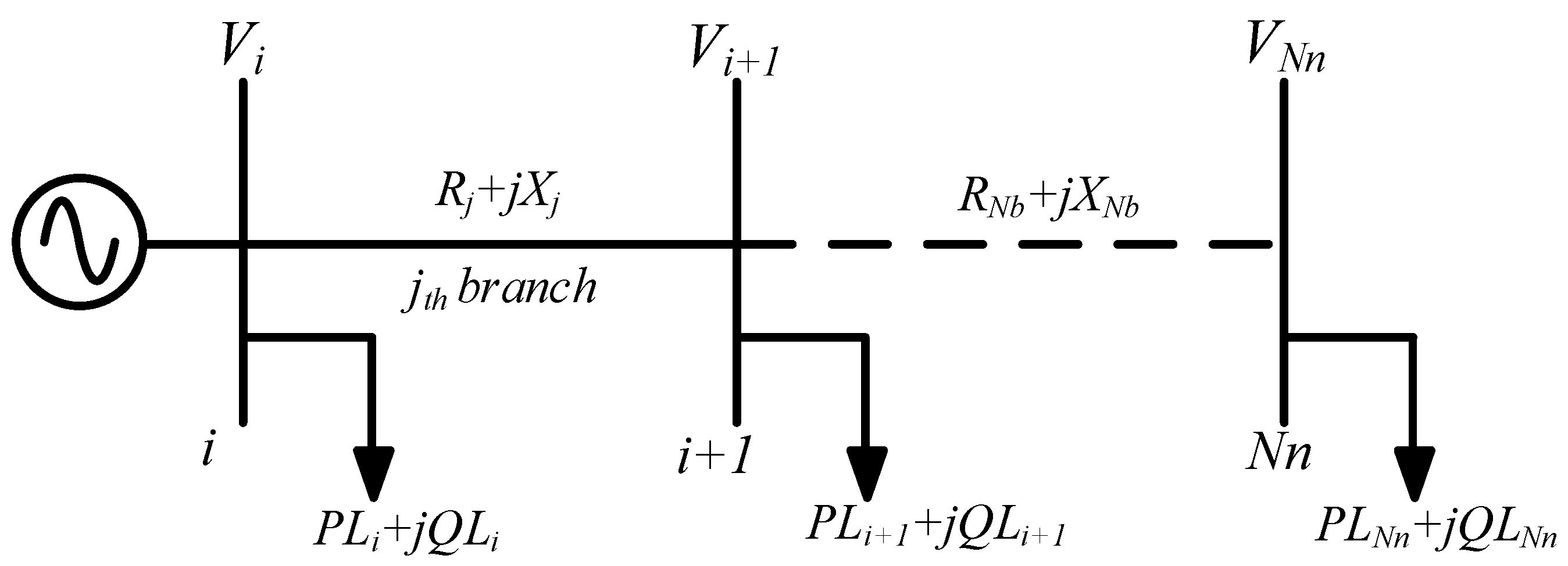
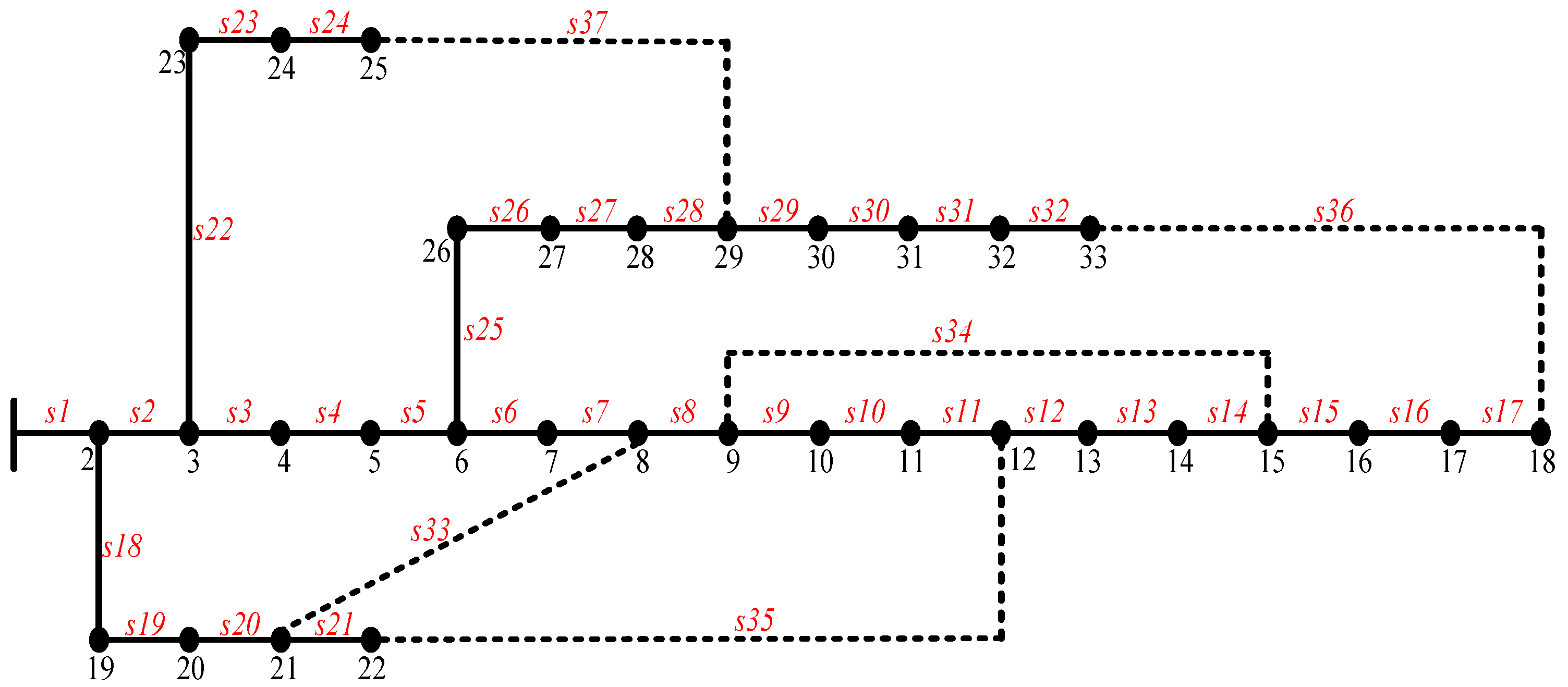
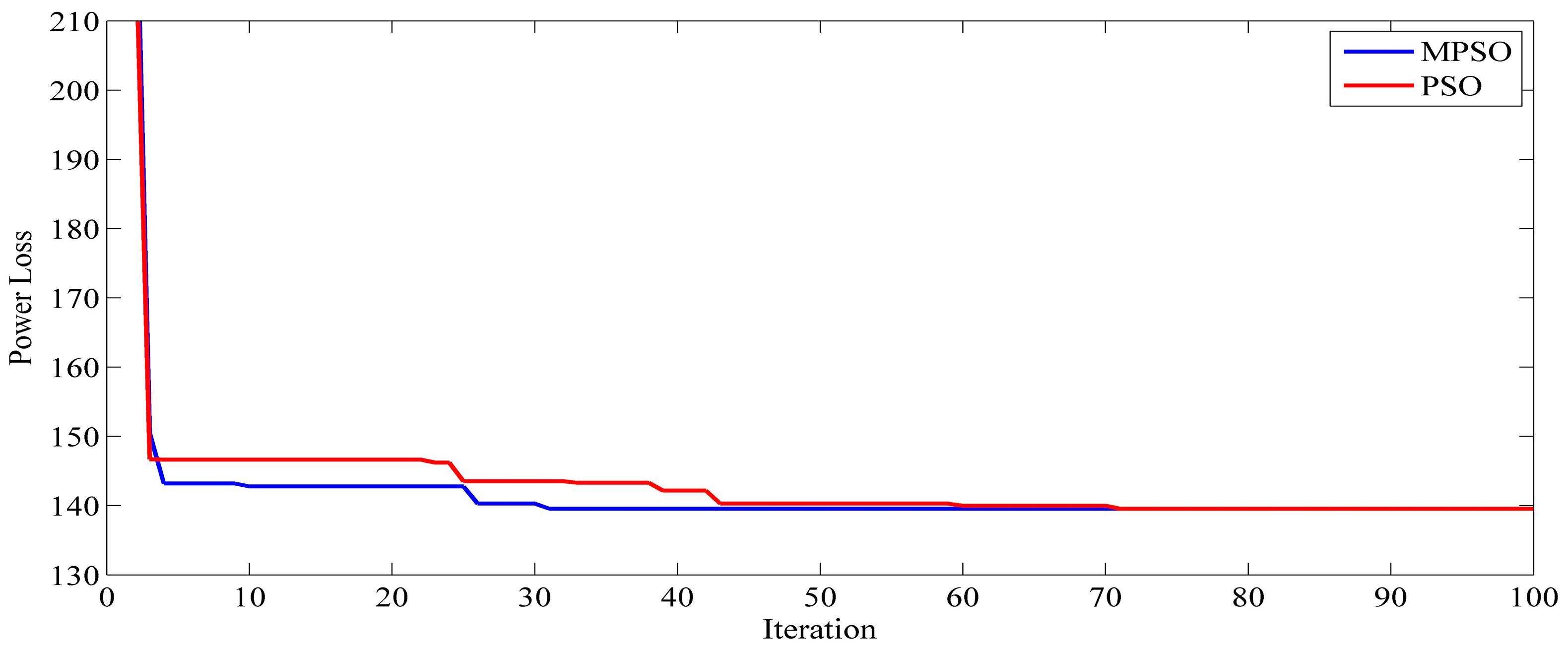
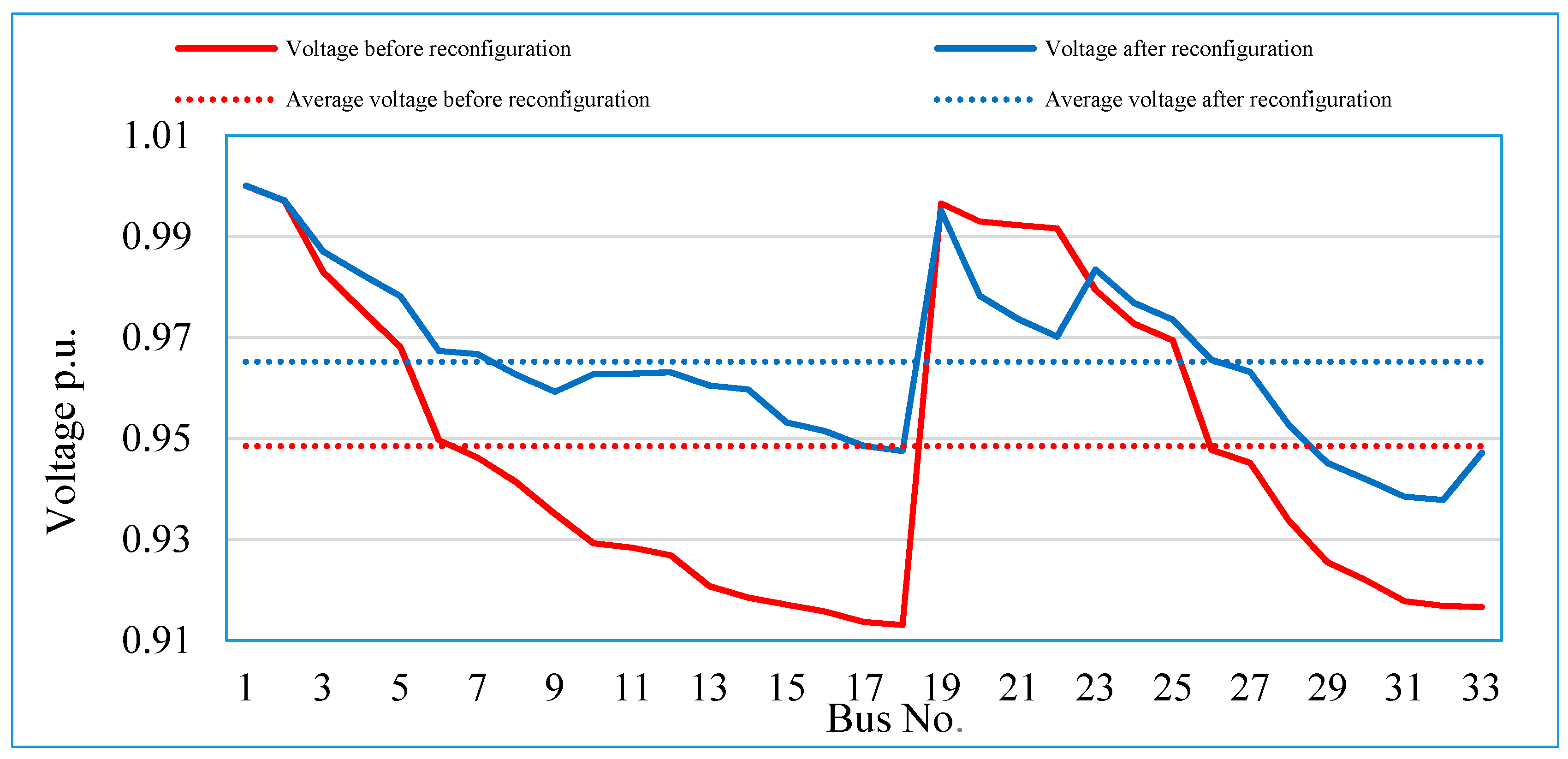
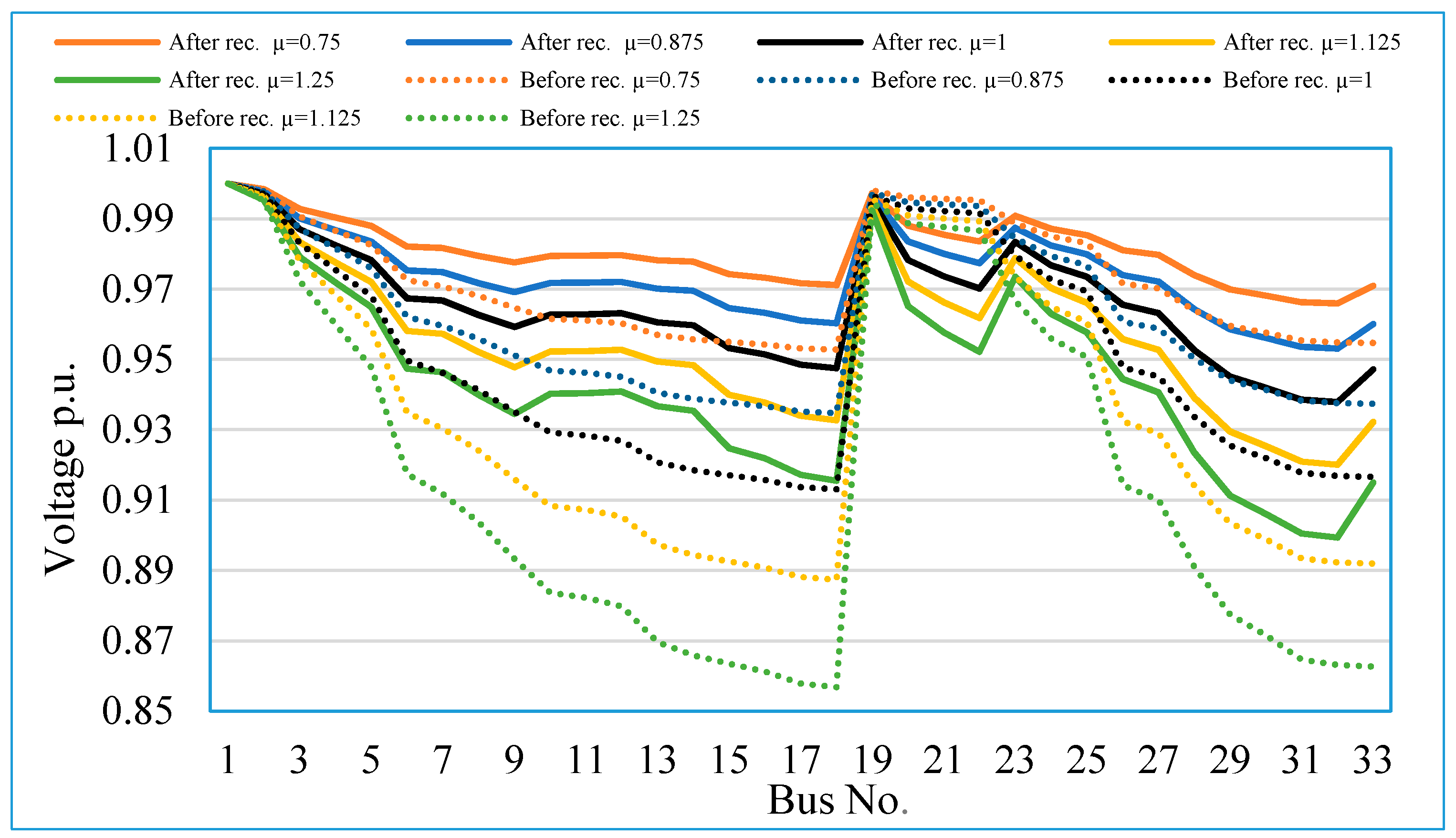
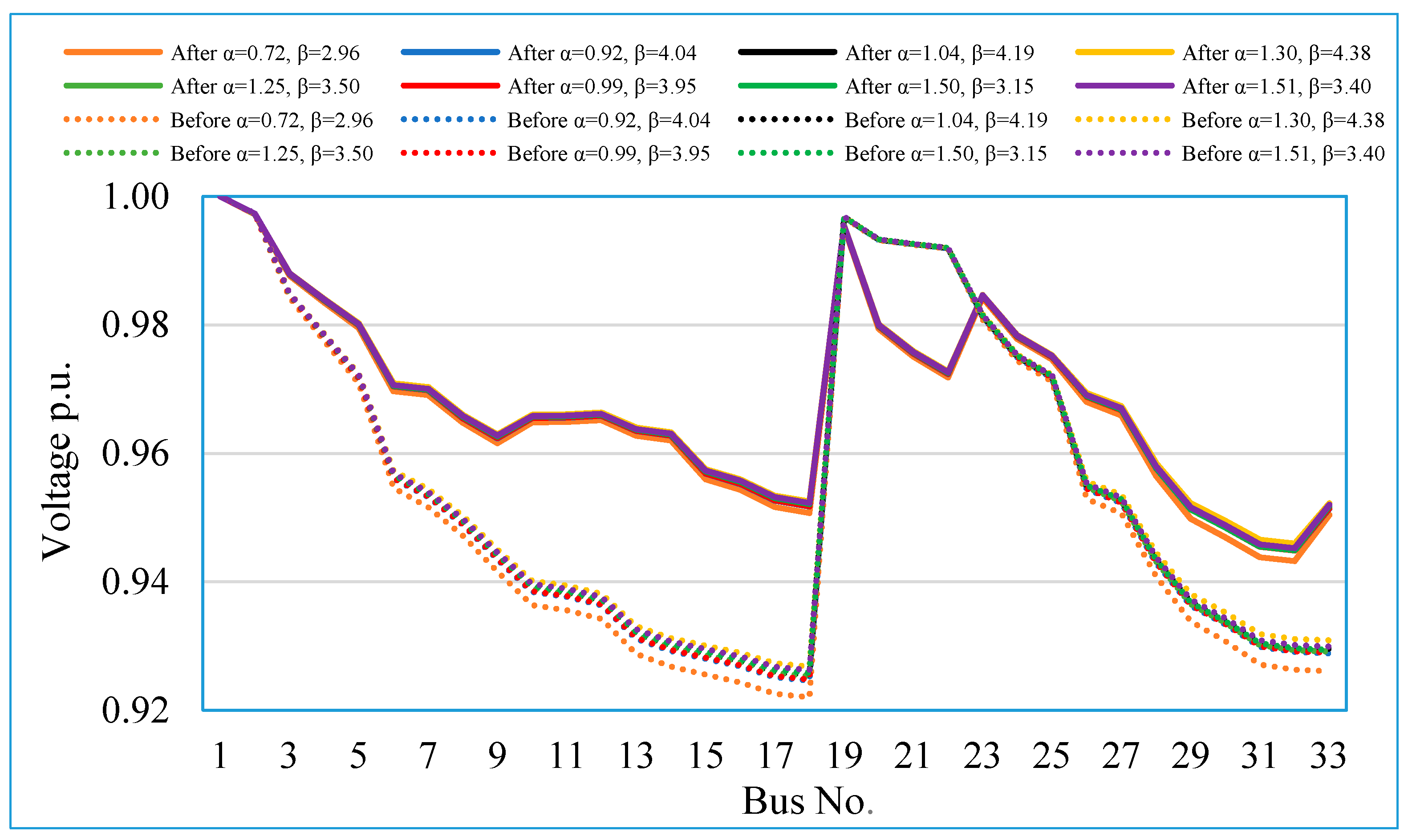
| No. | Parameters | PSO Values | MPSO Values |
|---|---|---|---|
| 1 | No. of birds (Npar) | 20 | 20 |
| 2 | Maximum number of bird steps | 100 | 100 |
| 3 | , | 1.2, 0.12 | - |
| 4 | , | - | Rand, Rand |
| 5 | wold | 0.8 | - |
| 6 | wmax, wmin | - | 1, 0.05 |
| 7 | Dimensions (ND) | 5 | 5 |
| 8 | , | Rand, Rand | Rand, Rand |
| Load Type | Condition | α | β |
|---|---|---|---|
| Residential Consumer | Spring and Summer/Day | 0.72 | 2.96 |
| Spring and Summer/Night | 0.92 | 4.04 | |
| Autumn and Winter/Day | 1.04 | 4.19 | |
| Autumn and Winter/Night | 1.30 | 4.38 | |
| Commercial Consumer | Spring and Summer/Day | 1.25 | 3.50 |
| Spring and Summer/Night | 0.99 | 3.95 | |
| Autumn and Winter/Day | 1.50 | 3.15 | |
| Autumn and Winter/Night | 1.51 | 3.40 |
| Methods | Open Switches | TPL (kW) | TQL (kVar) | TSL (kVA) | Vav (p.u.) | Vmin (p.u.) |
|---|---|---|---|---|---|---|
| Initial | s33, s34, s35, s36, s37 | 202.67 | 135.14 | 243.60 | 0.9485 | 0.9092 |
| Proposed method | s07, s09, s14, s32, s37 | 139.55 | 102.30 | 173.03 | 0.9652 | 0.9378 |
| FWA [2] | s07, s09, s14, s28, s32 | 139.98 | 104.88 | 174.91 | 0.9674 | 0.9413 |
| MBFOA [8] | s07, s09, s14, s28, s36 | 141.91 | 105.03 | 176.55 | 0.9678 | 0.9378 |
| ITS [13] | s07, s09, s14, s36, s37 | 142.16 | 102.71 | 175.39 | 0.9653 | 0.9336 |
| SLR [25] | s07, s10, s14, s36, s37 | 142.67 | 103.05 | 176.00 | 0.9651 | 0.9336 |
| Methods | Open Switches | TPL (kW) | TQL (kVar) | TSL (kVA) | Vav (p.u.) | Vmin (p.u.) |
|---|---|---|---|---|---|---|
| Initial | s33, s34, s35, s36, s37 | 109.75 | 73.13 | 131.89 | 0.9621 | 0.9362 |
| Proposed method | s07, s09, s14, s32, s37 | 76.61 | 56.16 | 94.99 | 0.9742 | 0.9540 |
| FWA [2] | s07, s09, s14, s28, s32 | 76.87 | 57.58 | 96.05 | 0.9758 | 0.9566 |
| MBFOA [8] | s07, s09, s14, s28, s36 | 77.88 | 57.64 | 96.89 | 0.9762 | 0.9540 |
| ITS [13] | s07, s09, s14, s36, s37 | 77.97 | 56.34 | 96.20 | 0.9743 | 0.9510 |
| SLR [25] | s07, s10, s14, s36, s37 | 78.25 | 56.52 | 96.53 | 0.9742 | 0.9510 |
| Methods | Open Switches | TPL (kW) | TQL (kVar) | TSL (kVA) | Vav (p.u.) | Vmin (p.u.) |
|---|---|---|---|---|---|---|
| Initial | s33, s34, s35, s36, s37 | 152.20 | 101.45 | 182.92 | 0.9553 | 0.9248 |
| Proposed method | s07, s09, s14, s32, s37 | 105.54 | 77.36 | 130.86 | 0.9698 | 0.9460 |
| FWA [2] | s07, s09, s14, s28, s32 | 105.88 | 79.32 | 132.30 | 0.9716 | 0.9490 |
| MBFOA [8] | s07, s09, s14, s28, s36 | 107.31 | 79.42 | 133.50 | 0.9720 | 0.9460 |
| ITS [13] | s07, s09, s14, s36, s37 | 107.46 | 77.64 | 132.58 | 0.9698 | 0.9423 |
| SLR [25] | s07, s10, s14, s36, s37 | 107.84 | 77.90 | 133.04 | 0.9697 | 0.9423 |
| Methods | Open Switches | TPL (kW) | TQL (kVar) | TSL (kVA) | Vav (p.u.) | Vmin (p.u.) |
|---|---|---|---|---|---|---|
| Initial | s33, s34, s35, s36, s37 | 261.69 | 174.54 | 314.56 | 0.9414 | 0.9011 |
| Proposed method | s07, s09, s14, s32, s37 | 178.84 | 131.11 | 221.76 | 0.9606 | 0.9295 |
| FWA [2] | s07, s09, s14, s28, s32 | 179.36 | 134.40 | 224.13 | 0.9631 | 0.9335 |
| MBFOA [8] | s07, s09, s14, s28, s36 | 181.91 | 134.63 | 226.31 | 0.9636 | 0.9295 |
| ITS [13] | s07, s09, s14, s36, s37 | 182.29 | 131.70 | 224.89 | 0.9607 | 0.9247 |
| SLR [25] | s07, s10, s14, s36, s37 | 182.95 | 132.14 | 225.69 | 0.9605 | 0.9247 |
| Methods | Open Switches | TPL (kW) | TQL (kVar) | TSL (kVA) | Vav (p.u.) | Vmin (p.u.) |
|---|---|---|---|---|---|---|
| Initial | s33, s34, s35, s36, s37 | 329.85 | 220.08 | 396.53 | 0.9342 | 0.8889 |
| Proposed method | s07, s09, s14, s32, s37 | 223.64 | 163.97 | 277.31 | 0.9560 | 0.9211 |
| FWA [2] | s07, s09, s14, s28, s32 | 224.25 | 168.06 | 280.24 | 0.9587 | 0.9256 |
| MBFOA [8] | s07, s09, s14, s28, s36 | 227.52 | 168.39 | 283.06 | 0.9593 | 0.9211 |
| ITS [13] | s07, s09, s14, s36, s37 | 228.08 | 164.77 | 281.38 | 0.9561 | 0.9156 |
| SLR [25] | s07, s10, s14, s36, s37 | 228.92 | 165.33 | 282.39 | 0.9558 | 0.9156 |
| Methods | Open Switches | TPL (kW) | TQL (kVar) | TSL (kVA) | Vav (p.u.) | Vmin (p.u.) |
|---|---|---|---|---|---|---|
| Initial | s33, s34, s35, s36, s37 | 164.41 | 109.27 | 197.41 | 0.9557 | 0.9221 |
| Proposed method | s07, s09, s14, s32, s37 | 120.97 | 88.87 | 150.11 | 0.9675 | 0.9432 |
| FWA [2] | s07, s09, s14, s28, s32 | 121.05 | 91.54 | 151.76 | 0.9694 | 0.9459 |
| MBFOA [8] | s07, s09, s14, s28, s36 | 123.05 | 91.21 | 153.17 | 0.9698 | 0.9430 |
| ITS [13] | s07, s09, s14, s36, s37 | 122.26 | 88.57 | 150.97 | 0.9677 | 0.9397 |
| SLR [25] | s07, s10, s14, s36, s37 | 122.71 | 88.86 | 151.50 | 0.9675 | 0.9397 |
| Methods | Open Switches | TPL (kW) | TQL (kVar) | TSL (kVA) | Vav (p.u.) | Vmin (p.u.) |
|---|---|---|---|---|---|---|
| Initial | s33, s34, s35, s36, s37 | 154.45 | 102.54 | 185.39 | 0.9552 | 0.9246 |
| Proposed method | s07, s09, s14, s32, s37 | 115.72 | 85.07 | 143.62 | 0.9682 | 0.9449 |
| FWA [2] | s07, s09, s14, s28, s32 | 116.94 | 87.75 | 146.20 | 0.9700 | 0.9474 |
| MBFOA [8] | s07, s09, s14, s28, s36 | 117.71 | 87.30 | 146.55 | 0.9705 | 0.9446 |
| ITS [13] | s07, s09, s14, s36, s37 | 116.69 | 84.61 | 144.14 | 0.9684 | 0.9416 |
| SLR [25] | s07, s10, s14, s36, s37 | 117.11 | 84.89 | 144.65 | 0.9682 | 0.9416 |
| Methods | Open Switches | TPL (kW) | TQL (kVar) | TSL (kVA) | Vav (p.u.) | Vmin (p.u.) |
|---|---|---|---|---|---|---|
| Initial | s33, s34, s35, s36, s37 | 151.64 | 100.65 | 182.01 | 0.9556 | 0.9254 |
| Proposed method | s07, s09, s14, s32, s37 | 114.34 | 84.05 | 141.92 | 0.9684 | 0.9453 |
| FWA [2] | s07, s09, s14, s28, s32 | 115.56 | 86.70 | 144.47 | 0.9702 | 0.9477 |
| MBFOA [8] | s07, s09, s14, s28, s36 | 116.28 | 86.24 | 144.77 | 0.9706 | 0.9450 |
| ITS [13] | s07, s09, s14, s36, s37 | 115.26 | 83.58 | 142.37 | 0.9686 | 0.9420 |
| SLR [25] | s07, s10, s14, s36, s37 | 115.67 | 83.85 | 142.87 | 0.9684 | 0.9420 |
| Methods | Open Switches | TPL (kW) | TQL (kVar) | TSL (kVA) | Vav (p.u.) | Vmin (p.u.) |
|---|---|---|---|---|---|---|
| Initial | s33, s34, s35, s36, s37 | 146.47 | 97.16 | 175.76 | 0.9564 | 0.9268 |
| Proposed method | s07, s09, s14, s32, s37 | 111.86 | 82.20 | 138.81 | 0.9688 | 0.9460 |
| FWA [2] | s07, s09, s14, s28, s32 | 113.02 | 84.77 | 141.28 | 0.9705 | 0.9484 |
| MBFOA [8] | s07, s09, s14, s28, s36 | 113.68 | 84.30 | 141.53 | 0.9709 | 0.9457 |
| ITS [13] | s07, s09, s14, s36, s37 | 112.68 | 81.70 | 139.18 | 0.9689 | 0.9428 |
| SLR [25] | s07, s10, s14, s36, s37 | 113.05 | 81.96 | 139.65 | 0.9688 | 0.9428 |
| Methods | Open Switches | TPL (kW) | TQL (kVar) | TSL (kVA) | Vav (p.u.) | Vmin (p.u.) |
|---|---|---|---|---|---|---|
| Initial | s33, s34, s35, s36, s37 | 152.23 | 101.04 | 182.72 | 0.9555 | 0.9253 |
| Proposed method | s07, s09, s14, s32, s37 | 115.13 | 84.54 | 142.83 | 0.9683 | 0.9449 |
| FWA [2] | s07, s09, s14, s28, s32 | 116.14 | 87.07 | 145.16 | 0.9701 | 0.9474 |
| MBFOA [8] | s07, s09, s14, s28, s36 | 116.96 | 86.69 | 145.59 | 0.9705 | 0.9446 |
| ITS [13] | s07, s09, s14, s36, s37 | 116.16 | 84.16 | 143.44 | 0.9685 | 0.9416 |
| SLR [25] | s07, s10, s14, s36, s37 | 116.56 | 84.41 | 143.92 | 0.9683 | 0.9416 |
| Methods | Open Switches | TPL (kW) | TQL (kVar) | TSL (kVA) | Vav (p.u.) | Vmin (p.u.) |
|---|---|---|---|---|---|---|
| Initial | s33, s34, s35, s36, s37 | 153.79 | 102.10 | 184.60 | 0.9553 | 0.9248 |
| Proposed method | s07, s09, s14, s32, s37 | 115.50 | 84.89 | 143.34 | 0.9683 | 0.9449 |
| FWA [2] | s07, s09, s14, s28, s32 | 116.68 | 87.54 | 145.87 | 0.9701 | 0.9474 |
| MBFOA [8] | s07, s09, s14, s28, s36 | 117.45 | 87.10 | 146.23 | 0.9705 | 0.9446 |
| ITS [13] | s07, s09, s14, s36, s37 | 116.47 | 84.44 | 143.86 | 0.9684 | 0.9416 |
| SLR [25] | s07, s10, s14, s36, s37 | 116.89 | 84.71 | 144.36 | 0.9683 | 0.9416 |
| Methods | Open Switches | TPL (kW) | TQL (kVar) | TSL (kVA) | Vav (p.u.) | Vmin (p.u.) |
|---|---|---|---|---|---|---|
| Initial | s33, s34, s35, s36, s37 | 150.52 | 99.88 | 180.64 | 0.9557 | 0.9258 |
| Proposed method | s07, s09, s14, s32, s37 | 114.58 | 84.07 | 142.12 | 0.9684 | 0.9449 |
| FWA [2] | s07, s09, s14, s28, s32 | 115.45 | 86.50 | 144.26 | 0.9702 | 0.9475 |
| MBFOA [8] | s07, s09, s14, s28, s36 | 116.30 | 86.16 | 144.74 | 0.9706 | 0.9447 |
| ITS [13] | s07, s09, s14, s36, s37 | 115.66 | 83.74 | 142.79 | 0.9685 | 0.9414 |
| SLR [25] | s07, s10, s14, s36, s37 | 116.04 | 83.98 | 143.25 | 0.9684 | 0.9417 |
| Methods | Open Switches | TPL (kW) | TQL (kVar) | TSL (kVA) | Vav (p.u.) | Vmin (p.u.) |
|---|---|---|---|---|---|---|
| Initial | s33, s34, s35, s36, s37 | 148.81 | 98.72 | 178.58 | 0.9560 | 0.9263 |
| Proposed method | s07, s09, s14, s32, s37 | 113.63 | 83.39 | 140.94 | 0.9685 | 0.9452 |
| FWA [2] | s07, s09, s14, s28, s32 | 114.54 | 85.83 | 143.13 | 0.9703 | 0.9478 |
| MBFOA [8] | s07, s09, s14, s28, s36 | 115.34 | 85.47 | 143.56 | 0.9707 | 0.9450 |
| ITS [13] | s07, s09, s14, s36, s37 | 114.63 | 83.02 | 141.54 | 0.9687 | 0.9420 |
| SLR [25] | s07, s10, s14, s36, s37 | 115.02 | 83.26 | 141.99 | 0.9685 | 0.9420 |
| Load Levels | µ | TPL (kW) | TQL (kVar) | TSL (kVA) | Vav (p.u.) | Vmin (p.u.) |
|---|---|---|---|---|---|---|
| Peak load level | 1.250 | 143.66 | 105.03 | 177.96 | 0.9696 | 0.9467 |
| Pre-peak level | 1.125 | 111.29 | 81.45 | 137.91 | 0.9738 | 0.9542 |
| Constant load [24] | 1 | 83.90 | 61.59 | 104.08 | 0.9779 | 0.9612 |
| Pre-light level | 0.875 | 61.32 | 45.31 | 76.24 | 0.9820 | 0.9681 |
| Light load level | 0.750 | 43.37 | 32.49 | 54.19 | 0.9860 | 0.9749 |
| Load Levels | µ | TPL (kW) | TQL (kVar) | TSL (kVA) | Vav (p.u.) | Vmin (p.u.) |
|---|---|---|---|---|---|---|
| Peak load level | 1.250 | 108.01 | 75.70 | 131.89 | 0.9778 | 0.9601 |
| Pre-peak level | 1.125 | 84.98 | 59.83 | 103.93 | 0.9822 | 0.9680 |
| Constant load [24] | 1 | 66.59 | 47.33 | 81.70 | 0.9865 | 0.9758 |
| Pre-light level | 0.875 | 52.68 | 38.10 | 65.02 | 0.9907 | 0.9819 |
| Light load level | 0.750 | 43.10 | 32.02 | 53.69 | 0.9950 | 0.9852 |
| Load Type | α | β | TPL (kW) | TQL (kVar) | TSL (kVA) | Vav (p.u.) | Vmin (p.u.) | |
|---|---|---|---|---|---|---|---|---|
| Constant load [24] | 0 | 0 | 83.90 | 61.59 | 104.08 | 0.9779 | 0.9612 | |
| Residential | Spring and Summer/Day | 0.72 | 2.96 | 73.41 | 53.98 | 91.12 | 0.9792 | 0.9642 |
| Spring and Summer/Night | 0.92 | 4.04 | 70.21 | 51.66 | 87.17 | 0.9796 | 0.9652 | |
| Autumn and Winter/Day | 1.04 | 4.19 | 69.53 | 51.16 | 86.32 | 0.9797 | 0.9654 | |
| Autumn and Winter/Night | 1.30 | 4.38 | 68.37 | 50.33 | 84.90 | 0.9799 | 0.9658 | |
| Commercial | Spring and Summer/Day | 1.25 | 3.50 | 70.58 | 51.93 | 87.63 | 0.9797 | 0.9652 |
| Spring and Summer/Night | 0.99 | 3.95 | 70.23 | 51.67 | 87.19 | 0.9796 | 0.9652 | |
| Autumn and Winter/Day | 1.50 | 3.15 | 70.76 | 52.07 | 87.85 | 0.9797 | 0.9652 | |
| Autumn and Winter/Night | 1.51 | 3.40 | 70.12 | 51.60 | 87.06 | 0.9798 | 0.9654 | |
| Load Type | α | β | TPL (kW) | TQL (kVar) | TSL (kVA) | Vav (p.u.) | Vmin (p.u.) | |
|---|---|---|---|---|---|---|---|---|
| Constant load [21] | 0 | 0 | 66.59 | 47.33 | 81.70 | 0.9865 | 0.9758 | |
| Residential | Spring and Summer/Day | 0.72 | 2.96 | 61.18 | 43.33 | 75.13 | 0.9873 | 0.9778 |
| Spring and Summer/ Night | 0.92 | 4.04 | 59.39 | 42.37 | 72.96 | 0.9876 | 0.9784 | |
| Autumn and Winter/ Day | 1.04 | 4.19 | 50.10 | 42.18 | 72.61 | 0.9876 | 0.9786 | |
| Autumn and Winter/ Night | 1.30 | 4.38 | 58.67 | 41.89 | 72.09 | 0.9878 | 0.9789 | |
| Commercial | Spring and Summer/Day | 1.25 | 3.50 | 60.03 | 42.84 | 73.75 | 0.9876 | 0.9784 |
| Spring and Summer/ Night | 0.99 | 3.95 | 59.49 | 42.45 | 73.08 | 0.9876 | 0.9784 | |
| Autumn and Winter/ Day | 1.50 | 3.15 | 60.44 | 43.14 | 74.26 | 0.9876 | 0.9784 | |
| Autumn and Winter/ Night | 1.51 | 3.40 | 60.05 | 42.87 | 73.78 | 0.9877 | 0.9786 | |
© 2017 by the authors. Licensee MDPI, Basel, Switzerland. This article is an open access article distributed under the terms and conditions of the Creative Commons Attribution (CC BY) license (http://creativecommons.org/licenses/by/4.0/).
Share and Cite
Flaih, F.M.F.; Lin, X.; Abd, M.K.; Dawoud, S.M.; Li, Z.; Adio, O.S. A New Method for Distribution Network Reconfiguration Analysis under Different Load Demands. Energies 2017, 10, 455. https://doi.org/10.3390/en10040455
Flaih FMF, Lin X, Abd MK, Dawoud SM, Li Z, Adio OS. A New Method for Distribution Network Reconfiguration Analysis under Different Load Demands. Energies. 2017; 10(4):455. https://doi.org/10.3390/en10040455
Chicago/Turabian StyleFlaih, Firas M. F., Xiangning Lin, Mohammed Kdair Abd, Samir M. Dawoud, Zhengtian Li, and Owolabi Sunday Adio. 2017. "A New Method for Distribution Network Reconfiguration Analysis under Different Load Demands" Energies 10, no. 4: 455. https://doi.org/10.3390/en10040455
APA StyleFlaih, F. M. F., Lin, X., Abd, M. K., Dawoud, S. M., Li, Z., & Adio, O. S. (2017). A New Method for Distribution Network Reconfiguration Analysis under Different Load Demands. Energies, 10(4), 455. https://doi.org/10.3390/en10040455






